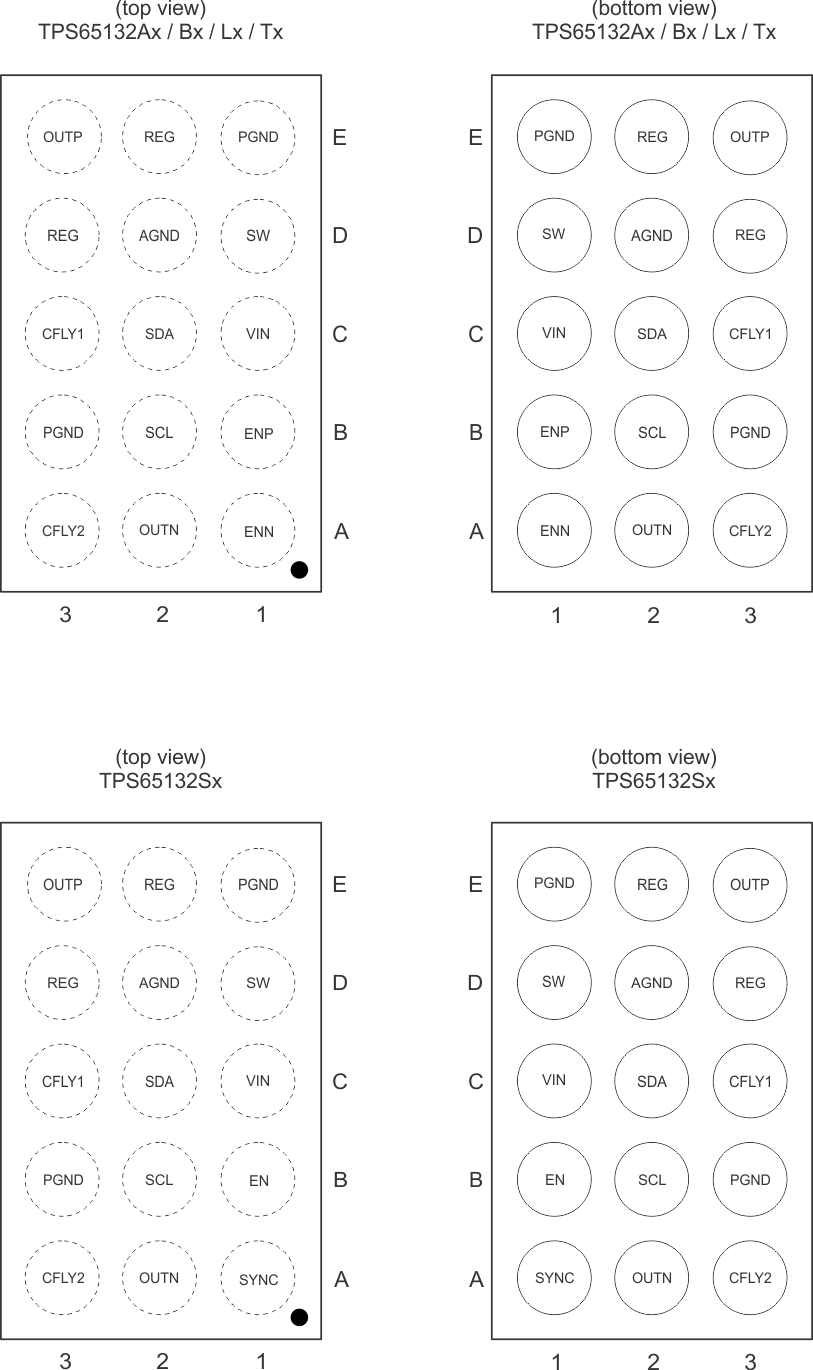ZHCSCH4H June 2013 – November 2016 TPS65132 , TPS65132S
UNLESS OTHERWISE NOTED, this document contains PRODUCTION DATA.
- 1 特性
- 2 应用范围
- 3 说明
- 4 修订历史记录
- 5 Device Comparison Table
- 6 Pin Configuration and Functions
- 7 Specifications
- 8 Detailed Description
-
9 Application and Implementation
- 9.1 Application Information
- 9.2
Typical Applications
- 9.2.1
Low-current Applications (≤ 40 mA)
- 9.2.1.1 Design Requirements
- 9.2.1.2 Detailed Design Procedure
- 9.2.1.3 Application Curves
- 9.2.2
Mid-current Applications (≤ 80 mA)
- 9.2.2.1 Design Requirements
- 9.2.2.2 Detailed Design Procedure
- 9.2.2.3 Application Curves
- 9.2.3 High-current Applications (≤ 150 mA)
- 9.2.1
Low-current Applications (≤ 40 mA)
- 10Power Supply Recommendations
- 11Layout
- 12器件和文档支持
- 13机械、封装和可订购信息
6 Pin Configuration and Functions
YFF Package
15 Bumps

Pin Functions
| PIN | I/O | DESCRIPTION | ||
|---|---|---|---|---|
| NAME | Ax, Bx, Lx, Tx | Sx | ||
| AGND | D2 | D2 | — | Analog ground |
| CFLY1 | C3 | C3 | I/O | Negative charge pump flying capacitor pin |
| CFLY2 | A3 | A3 | I/O | Negative charge pump flying capacitor pin |
| EN | — | B1 | Enable pin (sequence programmed) | |
| ENN | A1 | — | I | Enable pin for VNEG rail |
| ENP | B1 | B1 | I | Enable pin for VPOS rail |
| OUTP | E3 | E3 | O | Output pin of the LDO (VPOS) |
| OUTN | A2 | A2 | O | Output pin of the negative charge pump (VNEG) |
| PGND | B3 | B3 | — | Power ground |
| E1 | E1 | |||
| REG | D3 | D3 | I/O | Boost converter output pin |
| E2 | E2 | |||
| SCL | B2 | B2 | I/O | I²C interface clock signal pin |
| SDA | C2 | C2 | I/O | I²C interface data signal pin |
| SW | D1 | D1 | I/O | Switch pin of the boost converter |
| SYNC | — | A1 | I | Synchronization pin. 150 mA current enabled if this pin is pulled HIGH. |
| VIN | C1 | C1 | I | Input voltage supply pin |
Pin Functions
| PIN | I/O | DESCRIPTION | |
|---|---|---|---|
| NAME | Wx | ||
| AGND | 3 | — | Analog ground |
| 17 | |||
| CFLY1 | 13 | I/O | Negative charge pump flying capacitor pin |
| CFLY2 | 10 | I/O | Negative charge pump flying capacitor pin |
| ENN | 6 | I | Enable pin for VNEG rail |
| ENP | 5 | I | Enable pin for VPOS rail |
| OUTP | 16 | O | Output pin of the LDO (VPOS) |
| 15 | |||
| OUTN | 9 | O | Output pin of the negative charge pump (VNEG) |
| PGND | 1 | — | Power ground |
| 2 | |||
| 11 | |||
| 12 | |||
| REG | 14 | I/O | Boost converter output pin |
| 18 | |||
| SCL | 8 | I/O | I²C interface clock signal pin |
| SDA | 7 | I/O | I²C interface data signal pin |
| SW | 19 | I/O | Switch pin of the boost converter |
| 20 | |||
| VIN | 4 | I | Input voltage supply pin |
